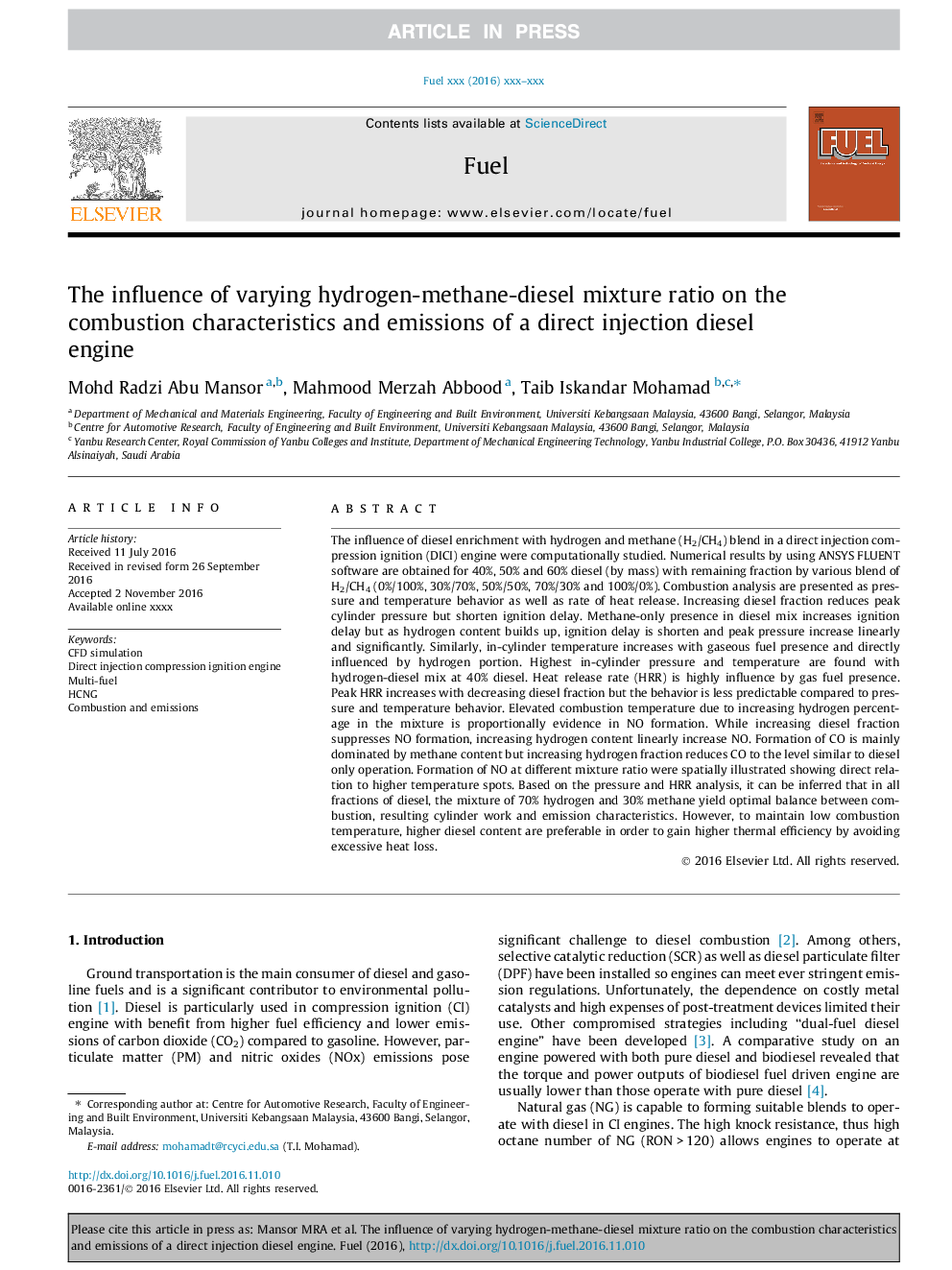| کد مقاله | کد نشریه | سال انتشار | مقاله انگلیسی | نسخه تمام متن |
|---|---|---|---|---|
| 6475596 | 1424974 | 2017 | 11 صفحه PDF | دانلود رایگان |
عنوان انگلیسی مقاله ISI
The influence of varying hydrogen-methane-diesel mixture ratio on the combustion characteristics and emissions of a direct injection diesel engine
ترجمه فارسی عنوان
تأثیر متغیر نسبت مخلوط هیدروژن-متان-دیزلی به ویژگی های احتراق و انتشار موتور دیزلی مستقیم
دانلود مقاله + سفارش ترجمه
دانلود مقاله ISI انگلیسی
رایگان برای ایرانیان
کلمات کلیدی
موضوعات مرتبط
مهندسی و علوم پایه
مهندسی شیمی
مهندسی شیمی (عمومی)
چکیده انگلیسی
The influence of diesel enrichment with hydrogen and methane (H2/CH4) blend in a direct injection compression ignition (DICI) engine were computationally studied. Numerical results by using ANSYS FLUENT software are obtained for 40%, 50% and 60% diesel (by mass) with remaining fraction by various blend of H2/CH4 (0%/100%, 30%/70%, 50%/50%, 70%/30% and 100%/0%). Combustion analysis are presented as pressure and temperature behavior as well as rate of heat release. Increasing diesel fraction reduces peak cylinder pressure but shorten ignition delay. Methane-only presence in diesel mix increases ignition delay but as hydrogen content builds up, ignition delay is shorten and peak pressure increase linearly and significantly. Similarly, in-cylinder temperature increases with gaseous fuel presence and directly influenced by hydrogen portion. Highest in-cylinder pressure and temperature are found with hydrogen-diesel mix at 40% diesel. Heat release rate (HRR) is highly influence by gas fuel presence. Peak HRR increases with decreasing diesel fraction but the behavior is less predictable compared to pressure and temperature behavior. Elevated combustion temperature due to increasing hydrogen percentage in the mixture is proportionally evidence in NO formation. While increasing diesel fraction suppresses NO formation, increasing hydrogen content linearly increase NO. Formation of CO is mainly dominated by methane content but increasing hydrogen fraction reduces CO to the level similar to diesel only operation. Formation of NO at different mixture ratio were spatially illustrated showing direct relation to higher temperature spots. Based on the pressure and HRR analysis, it can be inferred that in all fractions of diesel, the mixture of 70% hydrogen and 30% methane yield optimal balance between combustion, resulting cylinder work and emission characteristics. However, to maintain low combustion temperature, higher diesel content are preferable in order to gain higher thermal efficiency by avoiding excessive heat loss.
ناشر
Database: Elsevier - ScienceDirect (ساینس دایرکت)
Journal: Fuel - Volume 190, 15 February 2017, Pages 281-291
Journal: Fuel - Volume 190, 15 February 2017, Pages 281-291
نویسندگان
Mohd Radzi Abu Mansor, Mahmood Merzah Abbood, Taib Iskandar Mohamad,
